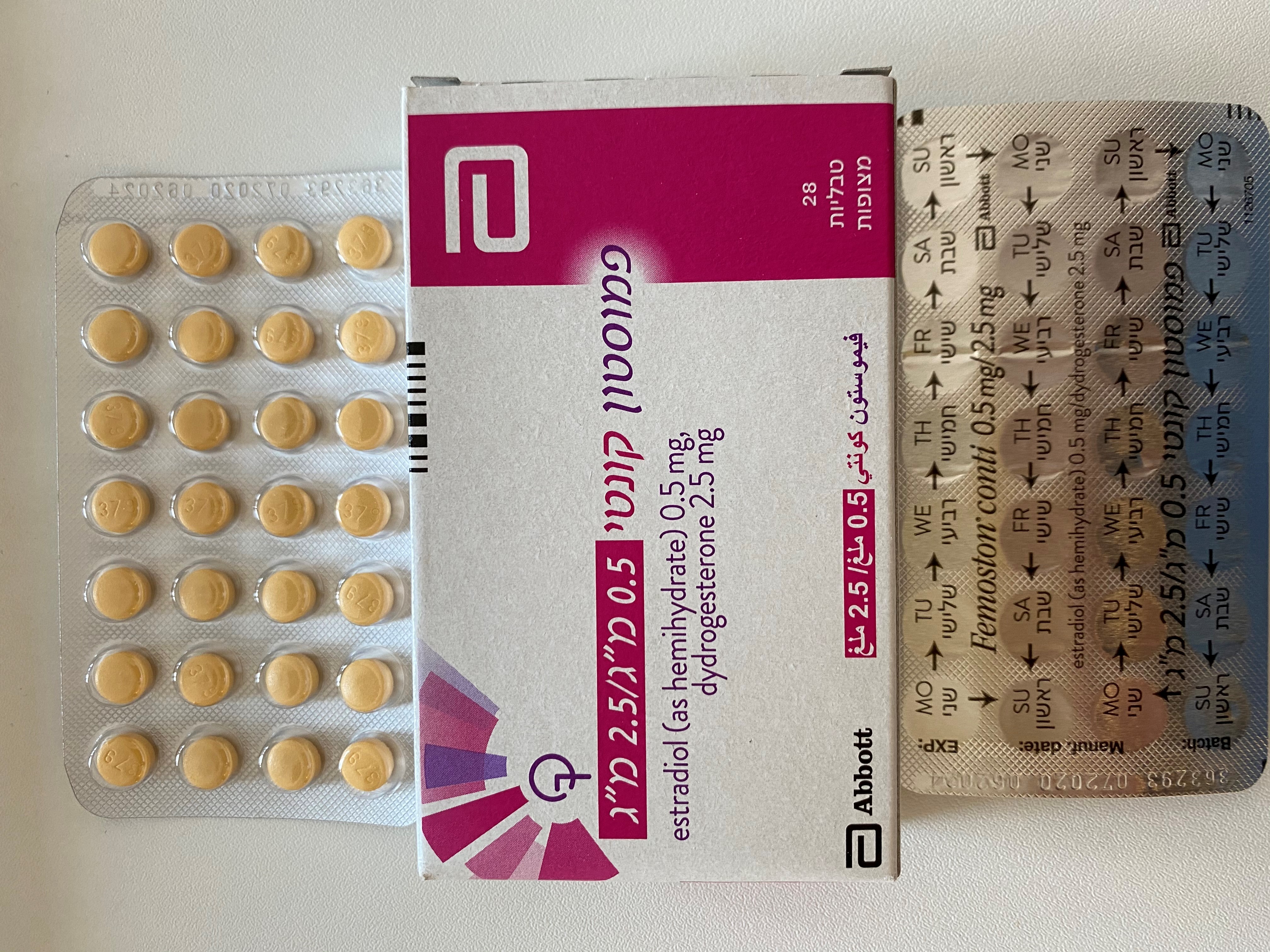Quest for the right Drug

פמוסטון קונטי 0.5 מ"ג/ 2.5 מ"ג FEMOSTON CONTI 0.5 MG/2.5 MG (DYDROGESTERONE, ESTRADIOL AS HEMIHYDRATE)
תרופה במרשם
תרופה בסל
נרקוטיקה
ציטוטוקסיקה
צורת מתן:
פומי : PER OS
צורת מינון:
טבליות מצופות פילם : FILM COATED TABLETS
עלון לרופא
מינוניםPosology התוויות
Indications תופעות לוואי
Adverse reactions התוויות נגד
Contraindications אינטראקציות
Interactions מינון יתר
Overdose הריון/הנקה
Pregnancy & Lactation אוכלוסיות מיוחדות
Special populations תכונות פרמקולוגיות
Pharmacological properties מידע רוקחי
Pharmaceutical particulars אזהרת שימוש
Special Warning עלון לרופא
Physicians Leaflet
Pharmacological properties : תכונות פרמקולוגיות
Pharmacodynamic Properties
5.1 Pharmacodynamic properties Pharmacotherapeutic group: Genito urinary system and sex hormones, progestogens and estrogens, fixed combinations. ATC code: G03FA14. Estradiol The active ingredient, synthetic 17β-estradiol, is chemically and biologically identical to endogenous human estradiol. It substitutes for the loss of estrogen production in menopausal women, and alleviates menopausal symptoms. Dydrogesterone Dydrogesterone is an orally-active progestogen having an activity comparable to parenterally administered progesterone. As estrogens promote the growth of the endometrium, unopposed estrogens increase the risk of endometrial hyperplasia and cancer. The addition of a progestogen greatly reduces the estrogen-induced risk of endometrial hyperplasia in non-hysterectomised women. Clinical trial information • Relief of estrogen-deficiency symptoms and bleeding patterns • Relief of menopausal symptoms was achieved during the first few weeks of treatment. With Femoston-conti 0.5 mg/2.5 mg the reduction of moderate to severe hot flushes was statistically significant versus placebo from week 4 onward. The number of moderate to severe hot flushes decreased further until end of treatment period in week 13. In two studies amenorrhoea (no bleeding or spotting) was seen in 91% and in 88% of the women respectively during months 10-12 of treatment. Irregular bleeding and or spotting appeared in 10% and 21% of the women during the first 3 months of treatment and in 9% and in 12% during months 10-12 of treatment.
Pharmacokinetic Properties
5.2 Pharmacokinetic properties Estradiol • Absorption: Absorption of estradiol is dependent on the particle size: micronized estradiol is readily absorbed from the gastrointestinal tract. The following table provides the mean steady state pharmacokinetic parameters of estradiol (E2), estrone (E1) and estrone sulphate (E1S) for each dose of micronized estradiol. Data is presented as mean (SD). Estradiol 0.5 mg Parameters E2 E1 Parameters E1S Cmax (pg/mL) 34.8 (30.4) 182 (110) Cmax (ng/mL) 6.98 (3.32) Cmin (pg/mL) - - - - Cav (pg/mL) 21.5 (16.0) - - - AUC0- (pg.h/mL) 516 (383) 2959 (2135) AUC0- (ng.h/mL) 82.0 (42.6) • Distribution: Estrogens can be found either unbound or bound. About 98- 99% of the estradiol dose binds to plasma proteins, from which about 30-52% to albumin and about 46-69% to the sex hormone-binding globulin (SHBG). • Biotransformation: Following oral administration, estradiol is extensively metabolised. The major unconjugated and conjugated metabolites are estrone and estrone sulphate. These metabolites can contribute to the estrogen activity, either directly or after conversion to estradiol. Estrone sulphate may undergo enterohepatic circulation. • Elimination: In urine, the major compounds are the glucuronides of estrone and estradiol. The elimination half-life is between 10-16 h. Estrogens are secreted in the milk of nursing mothers. • Dose and time dependencies: Following daily oral administration of Femoston-conti 0.5 mg/ 2.5mg, estradiol concentrations reached a steady-state after about five days. Generally, steady state concentrations appeared to be reached for within 8 to 11 days of dosing. Dydrogesterone • Absorption: Following oral administration, dydrogesterone is rapidly absorbed with a Tmax between 0.5 and 2.5 hours. The absolute bioavailability of dydrogesterone (oral 20 mg dose versus 7.8 mg intravenous infusion) is 28 %. The following table provides the mean steady state pharmacokinetic parameters of dydrogesterone (D) and dihydrodydrogesterone (DHD). Data is presented as mean (SD). Dydrogesterone 2.5 mg Parameters D DHD Cmax (ng/mL) 0.759 (0.313) 18.9 (7.22) Cmin (ng/mL) 0.0309 (0.0209) - Cav (ng/mL) 0.117 (0.0455) - AUC0- (ng.h/mL) 2.81 (1.09) 90.4 (44.1) • Distribution: After intravenous administration of dydrogesterone the steady-state volume of distribution is approximately 1400 L. Dydrogesterone and DHD are more than 90% bound to plasma proteins. • Biotransformation: Following oral administration, dydrogesterone is rapidly metabolised to DHD. The levels of the main active metabolite 20 α-dihydrodydrogesterone (DHD) peak about 1.5 hours postdose. The plasma levels of DHD are substantially higher as compared to the parent drug. The AUC and Cmax ratios of DHD to dydrogesterone are in the order of 40 and 25, respectively. Mean terminal half lives of dydrogesterone and DHD vary between 5 to 7 and 14 to 17 hours, respectively. A common feature of all metabolites characterised is the retention of the 4,6 diene-3-one configuration of the parent compound and the absence of 17α-hydroxylation. This explains the lack of estrogenic and androgenic effects of dydrogesterone. • Elimination: After oral administration of labelled dydrogesterone, on average 63% of the dose is excreted into the urine. Total plasma clearance is 6.4 L/min. Within 72 hours excretion is complete. DHD is present in the urine predominantly as the glucuronic acid conjugate. • Dose and time dependencies: The single and multiple dose pharmacokinetics are linear in the oral dose range 2.5 to 10 mg. Comparison of the single and multiple dose kinetics shows that the pharmacokinetics of dydrogesterone and DHD are not changed as a result of repeated dosing. Steady state was reached after 3 days of treatment.

שימוש לפי פנקס קופ''ח כללית 1994
לא צוין
תאריך הכללה מקורי בסל
לא צוין
הגבלות
לא צוין
מידע נוסף
